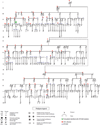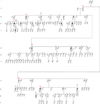Lynch syndrome-associated extracolonic tumors are rare in two extended families with the same EPCAM deletion
- PMID: 21769135
- PMCID: PMC3805505
- DOI: 10.1038/ajg.2011.203
Lynch syndrome-associated extracolonic tumors are rare in two extended families with the same EPCAM deletion
Abstract
Objectives: The Lynch syndrome (LS) is an inherited cancer syndrome showing a preponderance of colorectal cancer (CRC) in context with endometrial cancer and several other extracolonic cancers, which is due to pathogenic mutations in the mismatch repair (MMR) genes, MLH1, MSH2, MSH6, and PMS2. Some families were found to show a LS phenotype without an identified MMR mutation, although there was microsatellite instability and absence of MSH2 expression by immunohistochemistry. Studies of a subset of these families found a deletion at the 3' end of the epithelial cell adhesion molecule (EPCAM) gene, causing transcription read-through resulting in silencing of MSH2 through hypermethylation of its promoter. The tumor spectrum of such families appears to differ from classical LS.
Methods: Our study of two large families (USA Family R and Dutch Family A) with an EPCAM deletion was carried out using each institution's standard family study protocol. DNA was extracted from peripheral blood and EPCAM deletion analysis was performed.
Results: Both families were found to harbor the same deletion at the 3' end of EPCAM. Analysis showed that the deletion originated from a common ancestor. Family R and Family A members showed segregation of CRC with the presence of this EPCAM mutation. Compared with classic LS, there were almost no extracolonic cancers.
Conclusions: Members of Family R and Family A, all with the same EPCAM deletion, predominantly presented with CRC but no LS-associated endometrial cancer, confirming findings seen in other, smaller, LS families with EPCAM mutations. In these EPCAM mutation carriers, cancer surveillance should be focused on CRC.
Conflict of interest statement
Figures



References
-
- Ligtenberg MJL, Kuiper RP, Chan TL, et al. Heritable somatic methylation and inactivation of MSH2 in families with Lynch syndrome due to deletion of the 3 ´ exons of TACSTD1. Nat Genet. 2009;41:112–117. - PubMed
-
- Kobelka CE. Silencing is not-so golden: a new model for inheritance of Lynch syndrome. Clin Genet. 2009;75:522–523.
-
- Kovacs ME, Papp J, Szentirmay Z, et al. Deletions removing the last exon of TACSTD1 constitute a distinct class of mutations predisposing to Lynch syndrome. Hum Mutat. 2009;30:197–203. - PubMed
-
- Niessen RC, Hofstra RMW, Westers H, et al. Germline hypermethylation of MLH1 and EPCAM deletions are a frequent cause of Lynch syndrome. Genes Chromosomes Cancer. 2009;48:737–744. - PubMed
-
- Kuiper RP, Vissers LELM, Venkatachalam R, et al. Recurrence and variability of germline EPCAM deletions in Lynch syndrome. Hum Mutat. 2011;32:407–414. - PubMed
Publication types
MeSH terms
Substances
Grants and funding
LinkOut - more resources
Full Text Sources
Miscellaneous

